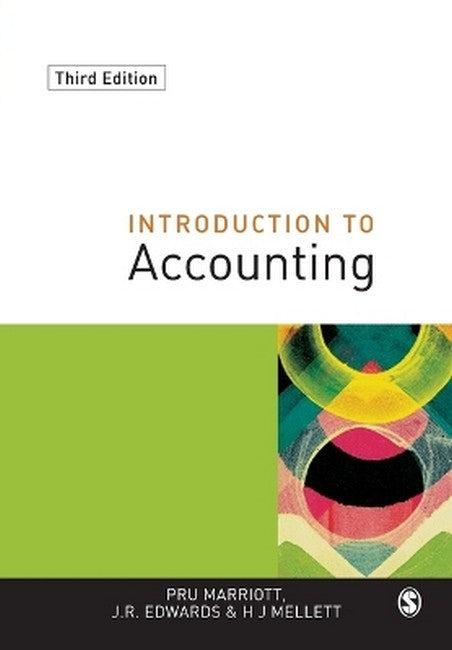THE FRAMEWORK OF ACCOUNTING The Accounting Process Suppliers of Accounting Information Financial Accounting and Management Accounting Compared External Users of Accounting Information Principal Accounting Statements THE BALANCE SHEET The Entity Concept Classification of Assets and Sources of Finance The Accounting Equation: A Further Illustration Raising Further Finance The Investment Decision Business Development The Trading Cycle Reporting Changes in Owner's Capital Assets = Capital + Liabilities Valuation of Assets PROFIT CALCULATED AS THE INCREASE IN CAPITAL Profitable Activity Profit and Changes In Gross Assets Balance Sheet Presentation: Vertical Format Profits, Losses and Changes In Net Assets Profit Measured By Capital Changes Capital Injections and Withdrawals THE PREPARATION OF ACCOUNTS FROM CASH OR INCOMPLETE RECORDS Accounting Systems and Information Requirements The Matching Concept Gross Profit and Net Profit The Problem of Periodic Profit Calculation The Identification of Revenue: The Realization Concept Matching Expenditure With Revenue: The Benefit Principle The Preparation of Accounts From Cash Records: A Worked Example Clubs and Societies THE DOUBLE ENTRY SYSTEM I The Inital Recording of Transactions Introduction Cash Flows Flows Of Goods And Services THE DOUBLE ENTRY SYSTEM II Ledger Accounts and the Trial Balance Introduction The Interlocking Effect of Transactions Ledger Accounts Books of Prime Entry Control Accounts For Debtors and Creditors The Trial Balance Computerized Accounting Systems Advantages of Double Entry THE DOUBLE ENTRY SYSTEM III Periodic Accounting Reports Periodic Accounts Adjustments To The Trial Balance Stocks (Inventories) Depreciation Disposal of Fixed Assets Prepayments and Accruals Bad Debts The Adjusted Trial Balance ASSET VALUATION, PROFIT MEASUREMENT AND THE UNDERLYING ACCOUNTING CONCEPTS Asset Valuation and Profit Measurement Tangible Fixed Assets Intangible Fixed Assets Stock Valuation Methods Accounting Concepts PARTNERSHIPS Introduction The Partnership Agreement The Creation of A Partnership The Division of Profit Capital and Current Accounts Changes in Membership Change in Profit-Sharing Ratio Dissolution of Partnerships COMPANY ACCOUNTS Formation of Registered Companies The Annual Report Other Sources of Information Share Capital Share Premium Account Share Forfeiture The Rights Issue Loan Capital and Debentures The Appropriation Account Revaluation Reserve Redemption of Debentures Bonus (Capitalization, Scrip) Issue of Shares Reporting Financial Performance (FRS 3) Groups of Companies Goodwill and Intangible Assets (FRS 10) Research and Development (SSAP 13) Limitations of Company Accounts INTERPRETATION OF ACCOUNTS The Cash Flow Statement Introduction Format Statement Construction Some Complexities of The Cash Flow Statement Interpretation using The Cash Flow Statement INTERPRETATION OF ACCOUNTS Ratio Analysis The Need for Profit and Cash Principles of Ratio Analysis Classification of Accounting Ratios Return on Capital Employed Profit Ratios Solvency Ratios Asset Turnover Ratios Relationship Between Accounting Ratios Gearing (or Leverage) Cash Flow Statement Ratios Limitations of Accounting Ratios Linking Together Cash Flow Analysis and Ratio Analysis DECISION-MAKING Introduction Cost Behaviour Total Costing and Overhead Recovery Rates Investment Appraisal Forecast Results STANDARD COSTING AND BUDGETARY CONTROL Introduction Budgetary Control Preparation of Budgets Standard Costing Calculation of Variances End of chapter questions (After each chapter) Solutions to activities (After each chapter)
Request Academic Copy
Please copy the ISBN for submitting review copy form
Description
`Introduction to Accounting has already stood the test of time, and this new and improved third edition will ensure that it remains one of the best, if not the "best ever" introductory textbooks on accounting'- Michael Sherer, University of Essex `I think the book admirably achieves the authors' objective of providing an introduction to accounting which embraces both the basic techniques and the underlying theoretical concepts'- Accounting and Business Research `...an excellent book which should be compulsory reading for all first year students on accounting degree courses'- Association of Banking Teachers Bulletin

